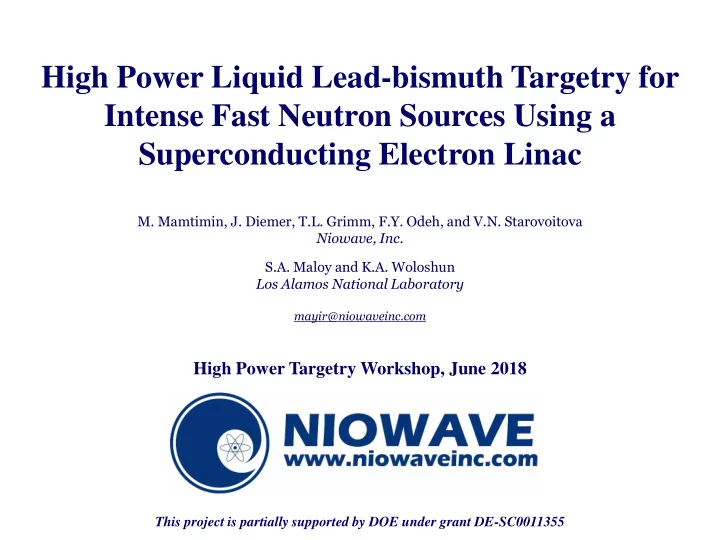

High Power Liquid Lead-bismuth Targetry for Intense Fast Neutron Sources Using a Superconducting Electron Linac M. Mamtimin, J. Diemer, T.L. Grimm, F.Y. Odeh, and V.N. Starovoitova Niowave, Inc. S.A. Maloy and K.A. Woloshun Los Alamos National Laboratory mayir@niowaveinc.com High Power Targetry Workshop, June 2018 This project is partially supported by DOE under grant DE-SC0011355
Outline ❖ About Niowave ❖ Uranium Target Assembly ❖ Hybrid Subcritical Testbed ❖ High Power Target ❖ Physics ❖ Target Material ❖ High Power Target Design ❖ Stagnant LBE target ❖ Forced flow LBE target ❖ LBE + NU target ❖ Corrosion Studies ❖ Summary and Future Work 2
Niowave, Inc. • Niowave is a world-wide leader in research, development, manufacturing and operation of superconducting electron linear accelerators. End Stations Turn-key Systems Beam Energy ~9 MeV • Superconducting Linac Average Beam Power 10-100 kW • Helium Cryoplant • Duty Cycle 10-100% Microwave Power • End Station Closed-loop Cooling 40-110 W • Licensing Capacity @ 4 K 3
Niowave’s Commercial Markets Sterilization & Advanced Manufacturing < 9 MeV Superconducting Electron Linacs Eliminate dirty bomb material Radiography & Active Interrogation 9 MeV Cargo inspection for contraband and shielded nuclear bombs Medical & Industrial Radioisotopes > 9 MeV Domestic supply without nuclear reactor or highly-enriched uranium Nuclear Energy Advanced Technologies > 9 MeV Domestic fast neutron irradiation and advanced reactor development 4
Niowave’s Subcritical Assembly • Subcritical uranium target assembly (UTA) • Water cooled pool type thermal assembly • Low enriched uranium • Driven by SEL and high power neutron target • Licensed by NRC NU LEU E-beam power 40 MeV, 530 kW 8.5 × 10 14 n/s Neutron source LEU fuel loading 10 kgU k eff 0.95 Fission power 210 kW Neutron source coupler 5
Hybrid Subcritical Testbed o Nuclear Reactors o Domestic fast neutron irradiation facility o Reactor Materials High power target o Radiation and corrosion resistant materials o Nuclear Fuel Cycle o Commercial closed-loop nuclear fuel cycle NU LBE Beam z(cm) ~30 LBE LBE C beam Ar Pump ~15 ~10 ~1 ~5 ~20 ~30 r(cm) C Neutron Source Internal Axial Reflector Outer Core Sample Irradiation Reflector Internal Structure Inner Core Internal Radial Reflector Shield 6
Photoneutron Production n n n n e - n n n Electrons brake and Photons cause Electrons are produce photonuclear reactions accelerated bremsstrahlung photons and liberate neutrons Niowave’s Superconducting High Power Neutron Target Linear Electron Accelerator 7
Target Material • High conversion efficiency (high Z) • High melting point (if the converter is solid) • If liquid, low melting point and good thermomechanical properties Lead-bismuth eutectic (LBE): • Z=82(45%),83(55%) • T melt = 124°C Isotope E th (MeV) Peak Value (mb) 2 H 2.22 2.5 9 Be 1.67 5 184 W 7.41 440 208 Pb 7.37 620 209 Bi 7.46 530 8
Target Design • Stagnant LBE • Feasibility studies • Low power demonstration • Forced flow LBE • Liquid metal pump • A fast neutron flux of 10 14 n/cm 2 /s • For small scale material studies (~ 10 mm 3 ) • LBE with uranium • Low power prototype • Higher neutron production yield 9
Stagnant LBE Target E e , Power, Average Flux, Peak Flux, MeV W #/cm^2/s #/cm^2/s 10 500 1.63E+08 8.30E+08 20 1200 1.02E+11 3.10E+11 35 1600 2.97E+11 7.50E+11 10
ANSYS Thermal Analysis At 40 MeV 5 kW: Max LBE T= 663 °C; Flow Rate = 15 cm/s Max SS T = 503 C Max SS Y = 179 MPa At 40 MeV 5 kW: SS window stress is above yield 11
Liquid Metal Pump Liquid metal mechanical pump LBE outlet LBE inlet Ferro fluid shaft seal • Better heat removal Sealed LBE container • Higher power operation • Minimum LBE temperature rise Band heater Impeller 50 kW LBE Temperaure Rise 1000.0 900.0 Temperature Rise ( C) 800.0 700.0 600.0 500.0 400.0 300.0 200.0 100.0 0.0 0 50 100 150 200 250 300 350 Flow rate (lb/min) 12
Windowless LBE Target • Eliminates thin SS window • High power operation electrons • Allows better coupling • Versatile: • Neutron source • Xray source • Positron target 13
LBE with Uranium Electron • Higher neutron production due to ( γ ,xn) and ( γ ,f) reactions • Gram quantities of uranium will increase peak neutron flux by a factor of 4 14
Corrosion Studies • LBE is corrosive: • Corrosion studies in up to 700 C LBE • Bimetal structures for high temperature components • Forced flow corrosion test station (erosion and corrosion) 15
Summary • Liquid metal based target development • Various high power neutron targets were designed, built, and tested • Radiation damage, corrosion, and erosion issues are being addressed • Versatility can be leveraged towards nuclear energy community and basic nuclear physics research 16
Recommend
More recommend